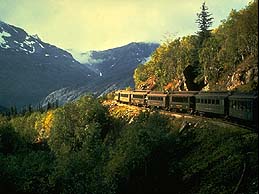
|
|
|
|
Gold Rush History of FairbanksGold fever struck Fairbanks and the areas surrounding this Interior Alaska city in 1902, and many people who sought the elusive gold nuggets never recovered. In Fairbanks, there is a replica Gold Rush street at Alaskaland, including original pioneer log cabins and a saloon offering a Gold Rush revue. The Alaskaland Pioneer Museum chronicles the lives of those who made their fortunes in the Interior (after the stampede) and has an exhibit of Rusty Hurlein's paintings of the era. Alaskaland also has a "mining valley" display, where the Alaska Salmon Bake is located. Fairbanks (actually Fox, a nearby community) boasts the only gold dredge open for public visit, Gold Dredge 8. Numerous museums are available, including the University of Alaska Museum.
 (Photograph from Al
(Photograph from AlFairbanks - in Alaska's heartlandFairbanks, the "golden heart" of Alaska's heartland, was a late bloomer in Gold Rush history. Earlier strikes include:
Gold was not discovered in Fairbanks until 1902. The story of Fairbanks gold reminds one of Robert Service's famous poem about the "strange things done in the midnight sun by the men who moil for gold." Felix Pedro, a patient prospector born Felice Pedroni, in Italy, spent years searching for gold in the creeks and valleys of the Tanana Valley where Fairbanks would sprout before he found the "American Klondike". E.T. Barnette, an ambitious trader with a shady past, and his wife, Isabelle were aboard the Lavelle Young in August 1901, hoping to establish a trading post far up the Tanana River. Low water conditions halted the vessel long before Barnette could reach his destination. Captain Charles Adams, co-owner of a sternwheel riverboat named Lavelle Young, turned into the Chena River, a tributary of the Tanana, instead. Again, shallow water stopped the Lavelle Young. Adams refused to go farther, so the Barnettes set up shop right there. One night Pedro told Barnette he had made some good "prospects." Barnette announced that he would stay and open a trading post right there on the Chena River. Pedro hurried back to his dig. On July 22, 1902. Pedro made his big strike! To create a market for his goods, Barnette dispatched Jujyra Wada, a Japanese immigrant from Ehime on Shikoku Island, to Dawson to spread the word that gold had been found. Wada went by way of the Yukon River and eventually reached the Klondike. Wada spread the word, and miners who had not already left for Nome flocked to Fairbanks. Unfortunately instead of the abundance of gold which Wada had been duped into telling them about, the prospectors found jobs working for Barnette - prospecting gold for him. According to a fictional version of Wada's life depicted in "Sushi and Sourdough," by Tooru J. Kanazawa: "... the stampeders' anger focused on Wada. In their view he had misled them. A miners' meeting... was held to determine if Wada should be hanged. The only defense Wada could offer was that he had been sent by Barnette." He was released with a warning to get out of town, which he promptly did. In the ensuing months, Fairbanks prospered. So did Barnette, as mayor of the new city, then as a banker. But not all was well. Trouble continued to stalk him. As gold production declined in Fairbanks, his bank collapsed. Angry depositors blamed Barnette, who departed Alaska in 1911, never to return. There were stories later that he was living the fancy life in Mexico. But to this day, nobody knows for certain what happened to E.T. Barnette. Felix Pedro died in Fairbanks, July 22, 1910 - exactly eight years after finding the Fairbanks gold. Wada moved on to Nome. The account in "Sushi and Sourdough" said that using what he had learned from Barnette, Wada went into business on behalf of the Eskimo people giving them a fair deal for their furs and ivory. They were so impressed and appreciative, they made him a chief. It was an short-lived honor, as disgruntled fur traders - mad about not being able to deal with the Eskimos directly - complained to the Bureau of Indian Affairs, which resurrected an old law that stated only a member of a tribe could be its chief. Nonetheless, Wada lived on as a legend of the Far North, an enduring folk hero worthy of any Robert Service rhyme:
|
| ||||||||